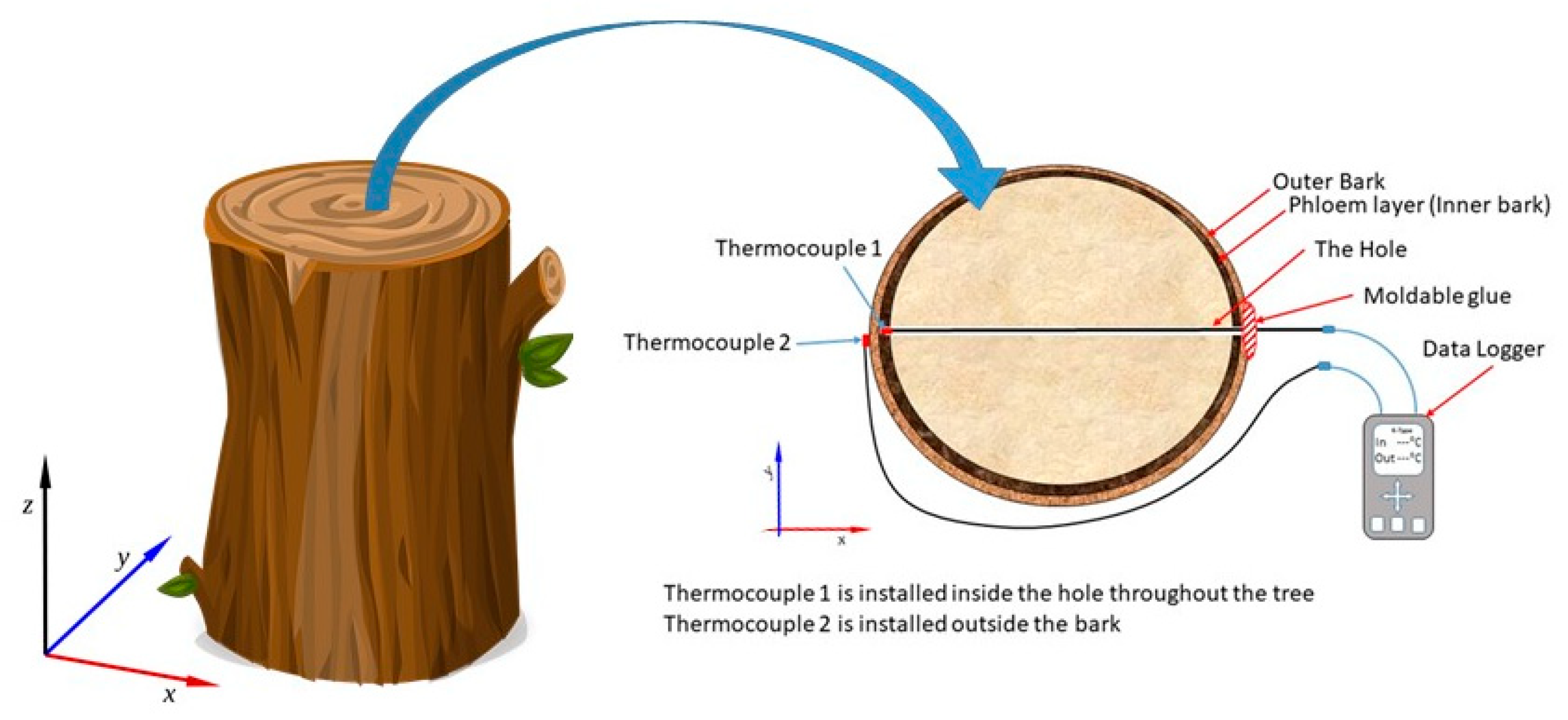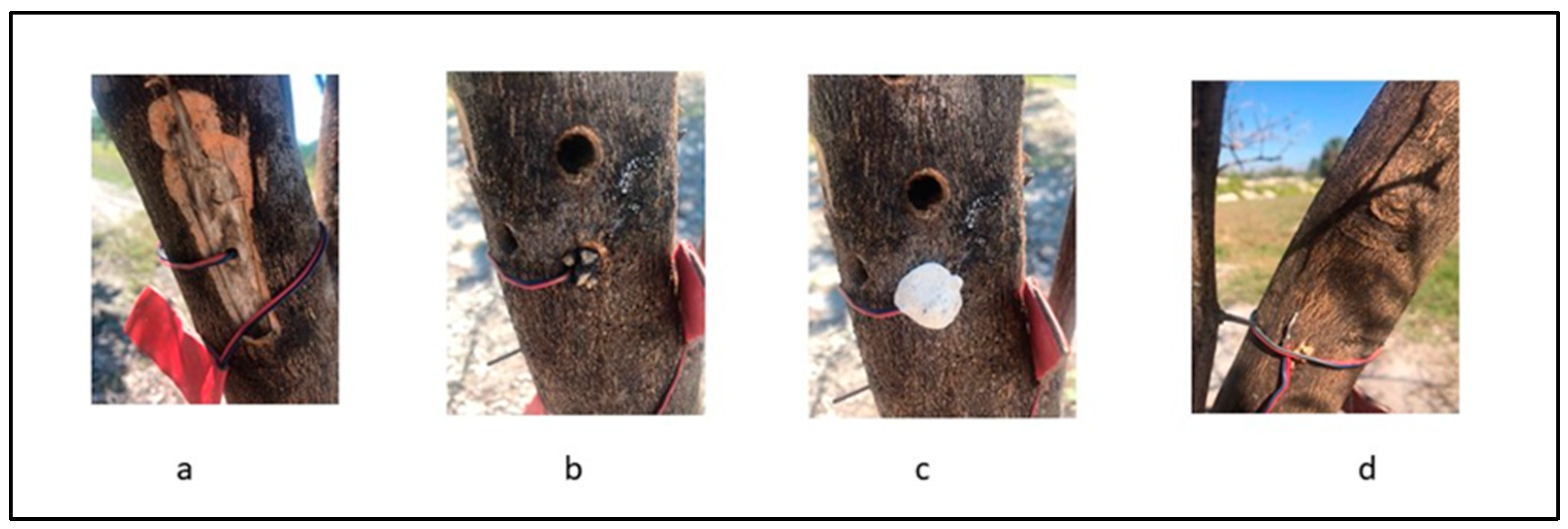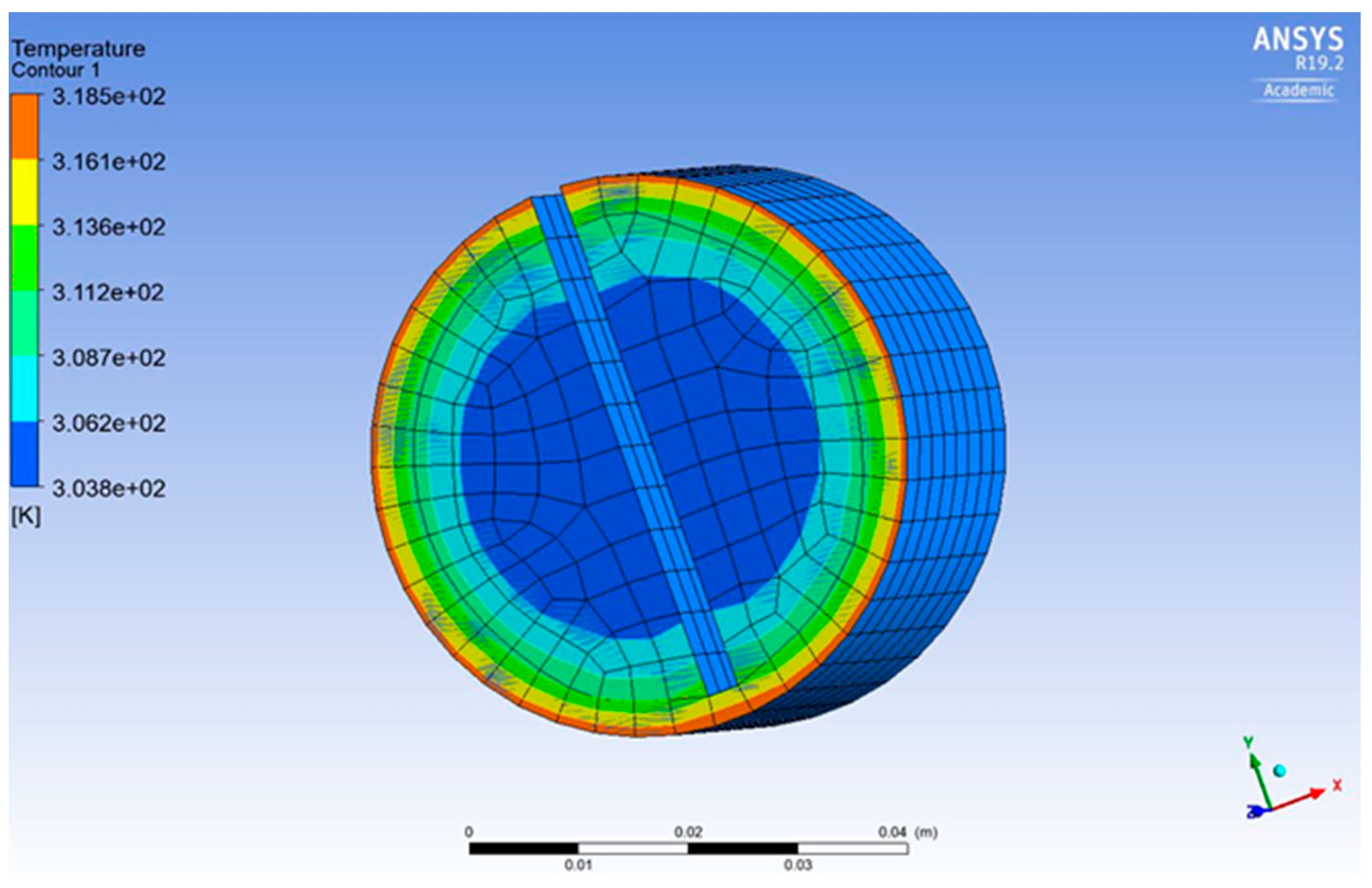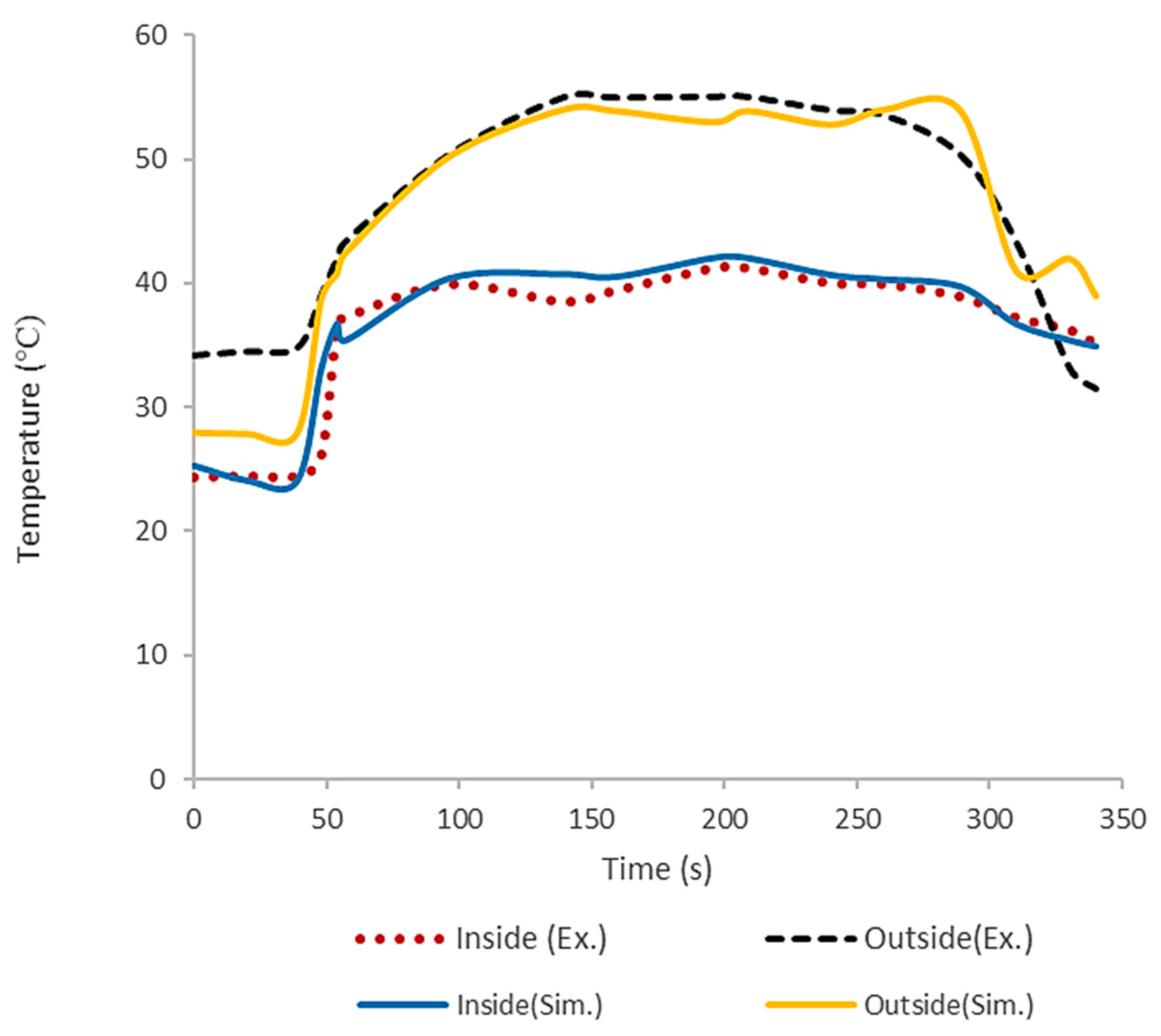Simulation and Evaluation of Heat Transfer Inside a Diseased Citrus Tree during Heat Treatment
Abstract
:1. Introduction
2. Materials and Methods
2.1. Experimental Procedure
2.2. Numerical Model and Simulation
3. Results and Discussion
3.1. Experimental Results
3.2. Simulation Results
4. Conclusions
Author Contributions
Funding
Institutional Review Board Statement
Informed Consent Statement
Data Availability Statement
Conflicts of Interest
Nomenclature
| HLM | Huanglongbing |
| MTS | Mobile Thermotherapy System |
| q | Heat flux vector (W) |
| T | Temperature (°C) |
| Tf | Environmental temperature |
| ∆T | Temperature difference between the surface and inside the phloem |
| λ | Thermal conductivity (W/(m·K)) |
| p | Density kg/m3 |
| t | Time (s) |
| ∂ | Diameter of the sample (m) |
| c | Special heat capacity (J/kg·K)) |
| h | Convective heat transfer coefficient (W/(m2·K)) |
| n | Normal direction of the isotherm level at one point in the direction of the temperature gradient |
References
- Oumarou, N.; Kocaefe, D.; Kocaefe, Y. 3D-modelling of conjugate heat and mass transfers: Effects of storage conditions and species on wood high temperature treatment. Int. J. Heat Mass Transf. 2014, 79, 945–953. [Google Scholar] [CrossRef]
- Grondeau, C.; Samson, R.; Sands, D.C. A Review of Thermotherapy to Free Plant Materials from Pathogens, Especially Seeds from Bacteria. Crit. Rev. Plant. Sci. 1994, 13, 57–75. [Google Scholar] [CrossRef]
- Hoffman, M.T.; Doud, M.S.; Williams, L.; Zhang, M.Q.; Ding, F.; Stover, E.; Hall, D.; Zhang, S.; Jones, L.; Gooch, M. Heat Treatment Eliminates “Candidatus Liberibacter asiaticus” from Infected Citrus Trees Under Controlled Conditions. Am. Phytopathol. Soc. 2013, 103, 15–22. [Google Scholar] [CrossRef] [PubMed] [Green Version]
- Ghatrehsamani, S.; Abdulridha, J.; Balafoutis, A.; Zhang, X.; Ehsani, R.; Ampatzidis, Y. Development and evaluation of a mobile thermotherapy technology for in-field treatment of Huanglongbing (HLB) affected trees. Biosyst. Eng. 2019, 182, 1–15. [Google Scholar] [CrossRef] [Green Version]
- Ghatrehsamani, S. A Review of Applied Methods for Treating HLB-Affected Tree. In Proceedings of the 2020 ASABE Annual International Meeting (ASABE AIM), St. Joseph, MI, USA, 13–15 July 2020. [Google Scholar]
- Lo, X. Studies on the sterilization effect of the intermittent hot water treatment on citrus budwood and nursling infected with citrus yellow shoot. J. S. China Agric. Univ. 1983, 1, 97–102. [Google Scholar]
- Czarnecka, E.; Verner, L.; Gurley, W.B. Liberibacter crescens as a surrogate to model survival of the bacterial pathogen L. asiaticus in heat treatments for citrus greening. In Proceedings of the 131st Annual Meeting of the Florida State Horticultural Society, Ft. Lauderdale, FL, USA, 10–11 June 2018. [Google Scholar]
- Ghatrehsamani, S.; Czarnecka, E.; Verner, F.L.; Gurley, W.B.; Ehsani, R.; Ampatzidis, Y. Evaluation of Mobile Heat Treatment System for Treating In-Field HLB-Affected Trees by Analyzing Survival Rate of Surrogate Bacteria. Agronomy 2019, 9, 540. [Google Scholar] [CrossRef] [Green Version]
- Inoue, M.; Norimoto, M.; Tanahashi, M.; Rowell, R.M. Steam or heat fixation of compressed wood. Wood Fiber Sci. 1993, 25, 224–235. [Google Scholar]
- Dubey, M.; Pang, S.; Walker, J. Changes in chemistry, color, dimensional stability and fungal resistance of Pinus radiata D. Don wood with oil heat-treatment. Holzforschung 2011, 66, 49–57. [Google Scholar] [CrossRef]
- Poncsák, S.; Kocaefe, D.; Bouazara, M.; Pichette, A. Effect of high temperature treatment on the mechanical properties of birch (Betula papyrifera). Wood Sci. Technol. 2006, 40, 647–663. [Google Scholar] [CrossRef]
- Militz, H. Thermal treatment of wood: European processes and their background. In Proceedings of the Conference on Enhancing the Durability of Lumber and Engineered Wood Products, Kissimmee, FL, USA, 11–13 February 2002. [Google Scholar]
- Jamsa, S.; Viitaniemi, P. Heat treatment of wood better durability without chemicals. Nord. Trebeskyttelsesdager 1998, 47–51. [Google Scholar]
- Korkut, S.; Akgul, M.; Dundar, T. The effects of heat treatment on some technological properties of Scots pine (Pinus sylvestris L.) wood. Bioresour. Technol. 2008, 99, 1861–1868. [Google Scholar] [CrossRef]
- Kamdem, D.P.; Pizzi, A.; Jermannaud, A. Durability of heat-treated wood. Holz Als Roh-und Werkstoff 2002, 60, 1–6. [Google Scholar] [CrossRef]
- Sanderman, W.; Augustin, H. Chemical investigation on the thermal decomposition of wood—Part III: Chemical investigation on the course of decomposition. Holz Als Roh-und Werkstoff 1963, 22, 377–386. [Google Scholar]
- Damann, K.E.J.; Benda, G.T.A. Evaluation of commercial heat-treatment methods for control of ratoon stunting disease of sugarcane. Plant. Dis. 1983, 67, 966–967. [Google Scholar] [CrossRef]
- Smith, G.R.; Fletcher, J.D.; Marroni, V.; Kean, J.M.; Stringer, L.D.; Vereijssen, J. Plant pathogen eradication: Determinants of successful programs. Australas. Plant. Pathol. 2017, 46, 277–284. [Google Scholar] [CrossRef]
- Panattoni, A.; Luvisi, A.; Triolo, E. Elimination of Viruses in Plants: Twenty years of progress. Span. J. Agric. Res. 2013, 11, 173–188. [Google Scholar] [CrossRef] [Green Version]
- Barba, M.; Ilardi, V.; Pasquini, G. Control of Pome and Stone Fruit Virus Diseases. Adv. Virus Res. 2015, 91, 47–83. [Google Scholar] [PubMed]
- Tasdemir, C.; Hiziroglu, S. Measurement of various properties of Southern pine and aspen as function of heat treatment. Measurement 2014, 49, 91–98. [Google Scholar] [CrossRef]
- Gebremedhin, K.G.; Wu, B. Simulation of flow field of a ventilated and occupied animal space with different inlet and outlet conditions. J. Therm. Biol. 2005, 30, 343–353. [Google Scholar] [CrossRef]
- Boulard, T.; Wang, S. Experimental and numerical studies on the heterogeneity of crop transpiration in a plastic tunnel. Comput. Electron. Agric. 2002, 34, 173–190. [Google Scholar] [CrossRef]
- Younsi, R.; Kadem, S.; Lachemet, A.; Kocaefe, D. Transient analysis of heat and mass transfer during heat treatment of wood including pressure equation. Therm. Sci. 2012, 19, 693–702. [Google Scholar] [CrossRef]
- Zhang, J.; Qu, L.; Wang, Z.; Zhao, Z.; He, Z.; Yi, S. Simulation and validation of heat transfer during wood heat treatment process. Results Phys. 2007, 7, 3806–3812. [Google Scholar] [CrossRef]
- Wang, Z.Y.; Qiu, S.; He, Z.B.; Yi, S.L. Heat transfer in the process of pyrolysis of garden waste. J. Beijing For. Univ. 2016. 38, 116–122.
- Chatziefstratiou, E.; Bohrer, G.; Bova, A.; Subramanian, R.; Frasson, R.; Scherzer, A.; Butler, B.W.; Dichinson, M.B. FireStem2D—A Two-Dimensional Heat Transfer Model for Simulating Tree Stem Injury in Fires. PLoS ONE 2013, 8, e70110. [Google Scholar] [CrossRef] [PubMed] [Green Version]









| Sample | Diameter (mm) | Bark Thickness (mm) |
|---|---|---|
| Very small | 5.07 | 0.57 |
| Small | 14.70 | 0.64 |
| Medium 1 | 25.19 | 1.04 |
| Large | 51.75 | 1.75 |
| Very large | 72.03 | 1.82 |
| Parameter (Unit) | Value |
|---|---|
| Density (kg/m3) | 7 × 102 |
| Transversal thermal conductivity (W/(m·K)) | 17 × 10−2 |
| Convective heat transfer coefficient (W/(m2·K)) [26] | 158 × 10−1 |
| Specific heat capacity (J/kg·K)) | 2310 |
| Initial temperature (°C) | 28 |
| Diameter Category | Mean (°C) | Standard Deviation (°C) |
|---|---|---|
| Very small | 1.14 | 0.64 |
| Small | 6.52 | 1.53 |
| Medium | 8.35 | 1.67 |
| Large | 9.50 | 2.23 |
| Very large | 11.73 | 2.15 |
| Time (s) | Average Temperature | |||||
|---|---|---|---|---|---|---|
| Experimental Results | Simulation Results | |||||
| °C | °K | °C | °K | |||
| 0 | Inside | 24.3 | 297.4 | Inside | 25.3 | 298.4 |
| Outside | 34.2 | 307.3 | Outside | 28.0 | 311.1 | |
| 29 | Inside | 24.4 | 297.5 | Inside | 30.8 | 304.0 |
| Outside | 34.8 | 307.9 | Outside | 34.8 | 307.9 | |
| 48 | Inside | 24.8 | 297.9 | Inside | 33.1 | 306.2 |
| Outside | 39.0 | 312.1 | Outside | 38.7 | 311.9 | |
| 57 | Inside | 37.2 | 310.3 | Inside | 35.3 | 308.5 |
| Outside | 43.3 | 316.4 | Outside | 42.4 | 315.5 | |
| 96 | Inside | 39.9 | 313.05 | Inside | 40.3 | 313.5 |
| Outside | 54.3 | 327.45 | Outside | 53.8 | 326.9 | |
| 159 | Inside | 39.4 | 312.1 | Inside | 40.5 | 313.6 |
| Outside | 54.9 | 328.0 | Outside | 53.9 | 327.0 | |
| 209 | Inside | 41.2 | 314.3 | Inside | 42.0 | 315.1 |
| Outside | 54.9 | 328.1 | Outside | 53.2 | 326.3 | |
| 260 | Inside | 39.9 | 315.0 | Inside | 40.3 | 313.4 |
| Outside | 53.5 | 326.6 | Outside | 54.0 | 327.1 | |
| 310 | Inside | 37.2 | 310.3 | Inside | 36.7 | 309.8 |
| Outside | 43.3 | 316.4 | Outside | 41.0 | 314.1 | |
Publisher’s Note: MDPI stays neutral with regard to jurisdictional claims in published maps and institutional affiliations. |
© 2021 by the authors. Licensee MDPI, Basel, Switzerland. This article is an open access article distributed under the terms and conditions of the Creative Commons Attribution (CC BY) license (http://creativecommons.org/licenses/by/4.0/).
Share and Cite
Ghatrehsamani, S.; Ampatzidis, Y.; Schueller, J.K.; Ehsani, R. Simulation and Evaluation of Heat Transfer Inside a Diseased Citrus Tree during Heat Treatment. AgriEngineering 2021, 3, 19-28. https://0-doi-org.brum.beds.ac.uk/10.3390/agriengineering3010002
Ghatrehsamani S, Ampatzidis Y, Schueller JK, Ehsani R. Simulation and Evaluation of Heat Transfer Inside a Diseased Citrus Tree during Heat Treatment. AgriEngineering. 2021; 3(1):19-28. https://0-doi-org.brum.beds.ac.uk/10.3390/agriengineering3010002
Chicago/Turabian StyleGhatrehsamani, Shirin, Yiannis Ampatzidis, John K. Schueller, and Reza Ehsani. 2021. "Simulation and Evaluation of Heat Transfer Inside a Diseased Citrus Tree during Heat Treatment" AgriEngineering 3, no. 1: 19-28. https://0-doi-org.brum.beds.ac.uk/10.3390/agriengineering3010002







